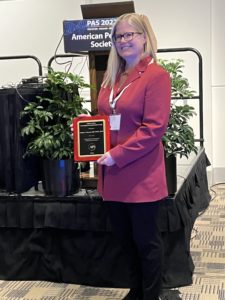
The Social Media and Adolescent Health Research Team, or SMAHRT, has produced more than 150 published papers in national and international journals. Their timely work addresses new and pressing issues in adolescent health that have emerged as adolescents spend ever more time on social media. The group’s creator, director, and principal investigator is Megan Moreno, MD, MSEd, MPH, vice chair of Academic Affairs and professor and division chief of General Pediatrics and Adolescent Medicine. Her insight, focus, dedication, leadership, and prodigious efforts in adolescent health and social media research have resulted in her being awarded the 2022 Norman J. Siegel Outstanding Science Award by the American Pediatric Society (APS). The award was presented at the April meeting of the Pediatric Academic Societies during the APS Presidential Plenary.

This award is just the most recent accolade bestowed on Moreno since she joined the University of Wisconsin–Madison’s School of Medicine and Public Health’s faculty in 2017 as a full professor, formerly of the University of Washington, where she had served as an associate professor of Adolescent Medicine since 2012. Among her recent honors are the Richard B. Heyman Award for Community Leadership from the American Academy of Pediatrics (AAP) in 2019, and the Holroyt-Sherry Award for Career Achievement from the AAP in 2020. Further, in 2021 Moreno was awarded the WARF Kellet Mid-Career Fellowship. One of UW–Madison’s highest mid-career honors, the Kellet Fellowship confers a substantial research grant.
Moreno attended Northwestern University as an undergraduate in political science. She chose this major not because she hadn’t decided on a medical career, but because she already had. Said Moreno, “I wanted to learn to read critically and evaluate a wide range of topics. Most importantly, I wanted to be able to write coherently and effectively about complex subjects—I knew I’d need these skills as a physician and researcher. Political science, combined with the requisite science courses, seemed a good foundation for medical school.”
Moreno’s medical education at George Washington University School of Medicine in Washington D.C. was followed by a residency in pediatrics at the University of Wisconsin–Madison, where she served as Chief Resident. A subsequent fellowship in adolescent medicine at Seattle Children’s focused her attention on the intersection of adolescent health and social media. As social media applications multiplied and evolved in the mid-2000s, Moreno learned that social media was being used by adolescents in intriguing ways: for example, homeless youth in Seattle were using the application MySpace, the first application to reach a global audience. “It allowed them to connect with their peers in ways that had been impossible before,” said Moreno. “MySpace helped them find what they needed to survive on the streets: food, shelter, safety, peer connection—essential information. It was a game changer.”
Moreno’s interest in social media and its intersection with adolescent health evolved as technology did. “Social media has affected the space of adolescence in profound ways,” noted Moreno. “Increased connectivity and access provide unimaginable benefits, but also generate unpredictable hazards and challenges. In SMAHRT, we examine the health effects as adolescents use social media to explore their identities and find their way in the world.”
SMAHRT’s group includes five core researchers and 15 to 18 student researchers. The team has investigated and published many reports on social media technology use and misuse, online safety, and effects of social media on adolescent health. In January 2022, a SMAHRT study was published in the Journal of Studies on Alcohol and Drugs regarding online cannabis advertising, which can appeal to youth. “SMAHRT doesn’t hold an opinion or a political viewpoint,” explained Moreno. “As clinicians and researchers, we follow the data. If the data indicate apparent targeting and manipulation of an underage audience, we report that in our findings.”
While Moreno has received many honors for her research, she is quick to give credit to the whole SMAHRT team. The core group of staff, who have been with her for three to 10 years, and dedicated student researchers are all deeply involved in developing, conducting, and analyzing surveys; finding and correlating data, and always brainstorming about new projects. “The team is essential,” explained Moreno. “The diversity among our team members and trainees brings different ideas and different perspectives into the research effort. It’s our shared values and strong collaboration that allow our mission to thrive.”